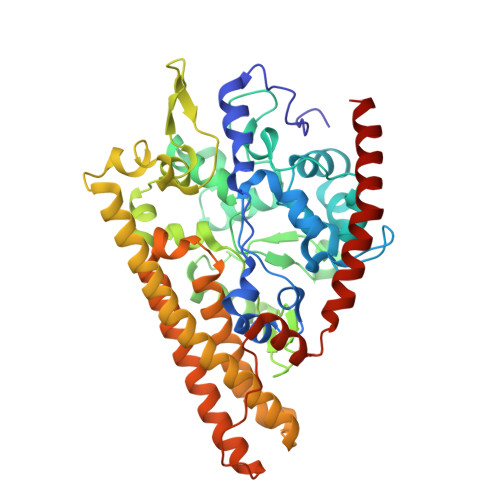Trapping of a Putative Intermediate in the CytochromecNitrite Reductase (ccNiR)-Catalyzed Reduction of Nitrite: Implications for the ccNiR Reaction Mechanism.
Ali, M., Stein, N., Mao, Y., Shahid, S., Schmidt, M., Bennett, B., Pacheco, A.A.(2019) J Am Chem Soc 141: 13358-13371
- PubMed: 31381304
- DOI: https://doi.org/10.1021/jacs.9b03036
- Primary Citation of Related Structures:
6P73 - PubMed Abstract:
Cytochrome c nitrite reductase (ccNiR) is a periplasmic, decaheme homodimeric enzyme that catalyzes the six-electron reduction of nitrite to ammonia. Under standard assay conditions catalysis proceeds without detected intermediates, and it has been assumed that this is also true in vivo. However, this report demonstrates that it is possible to trap a putative intermediate by controlling the electrochemical potential at which reduction takes place. UV/vis spectropotentiometry showed that nitrite-loaded Shewanella oneidensis ccNiR is reduced in a concerted two-electron step to generate an {FeNO} 7 moiety at the active site, with an associated midpoint potential of +246 mV vs SHE at pH 7. By contrast, cyanide-bound active site reduction is a one-electron process with a midpoint potential of +20 mV, and without a strong-field ligand the active site midpoint potential shifts 70 mV lower still. EPR analysis subsequently revealed that the {FeNO} 7 moiety possesses an unusual spectral signature, different from those normally observed for {FeNO} 7 hemes, that may indicate magnetic interaction of the active site with nearby hemes. Protein film voltammetry experiments previously showed that catalytic nitrite reduction to ammonia by S. oneidensis ccNiR requires an applied potential of at least -120 mV, well below the midpoint potential for {FeNO} 7 formation. Thus, it appears that an {FeNO} 7 active site is a catalytic intermediate in the ccNiR-mediated reduction of nitrite to ammonia, whose degree of accumulation depends exclusively on the applied potential. At low potentials the species is rapidly reduced and does not accumulate, while at higher potentials it is trapped, thus preventing catalytic ammonia formation.
Organizational Affiliation:
Department of Chemistry and Biochemistry , University of Wisconsin-Milwaukee , Milwaukee , Wisconsin 53211 , United States.

















